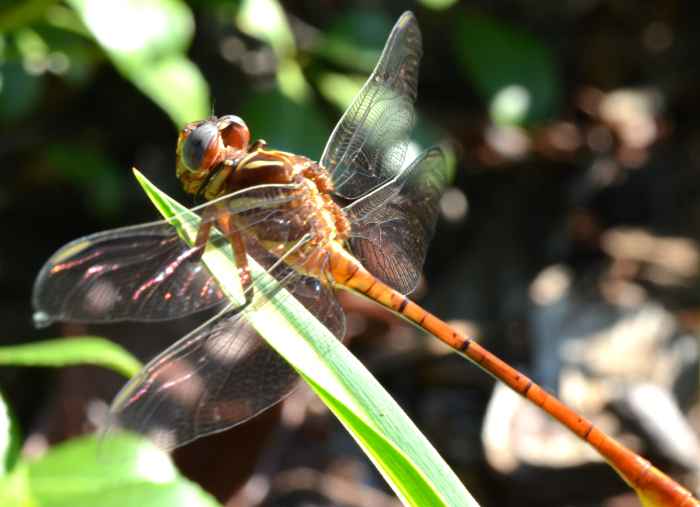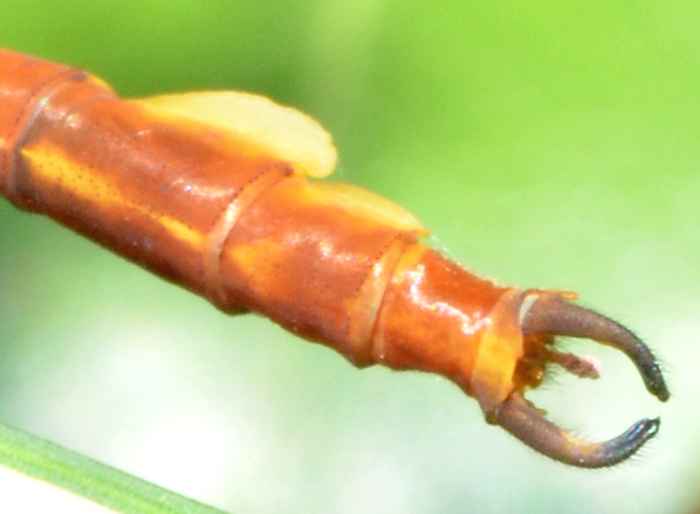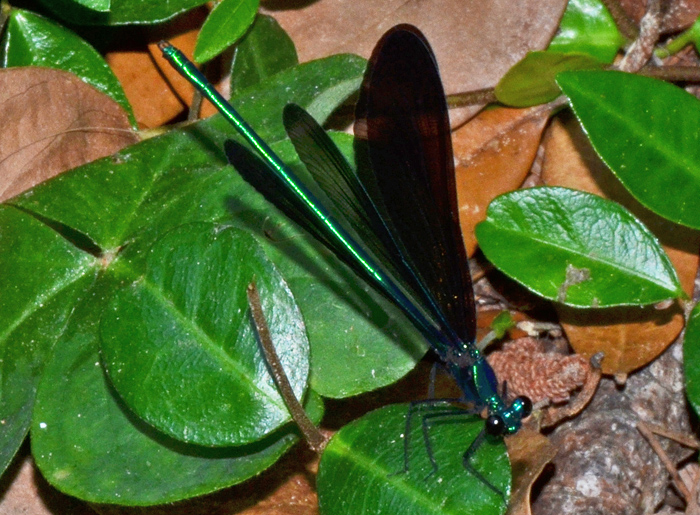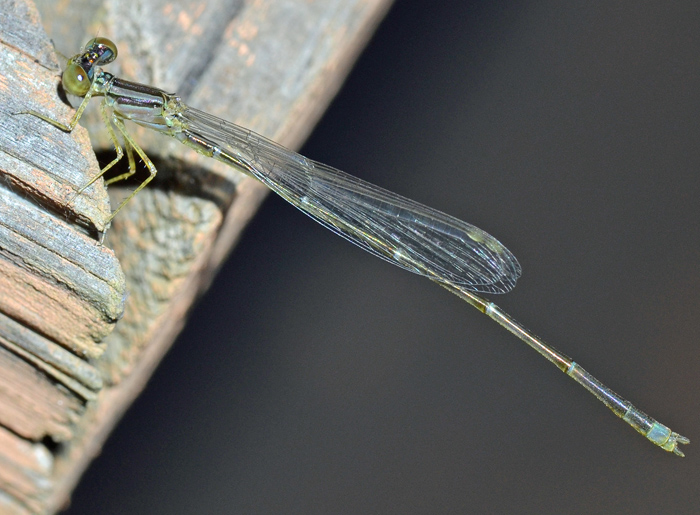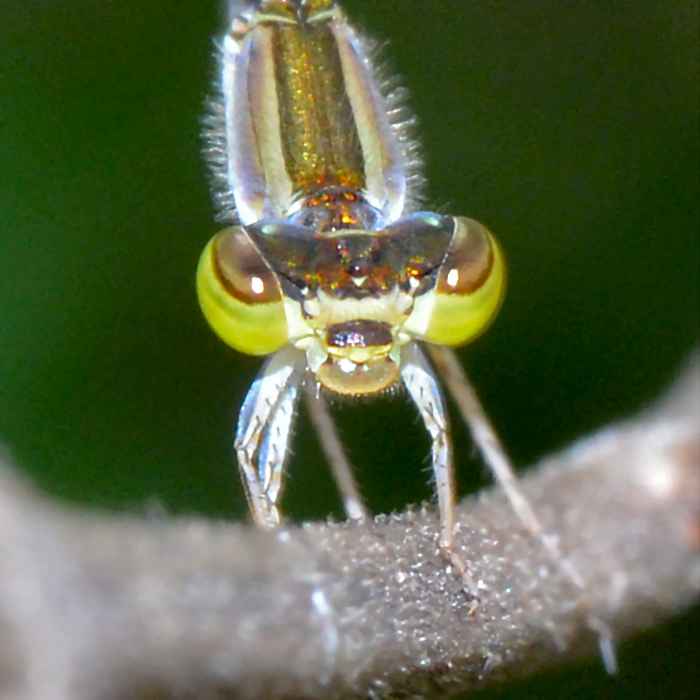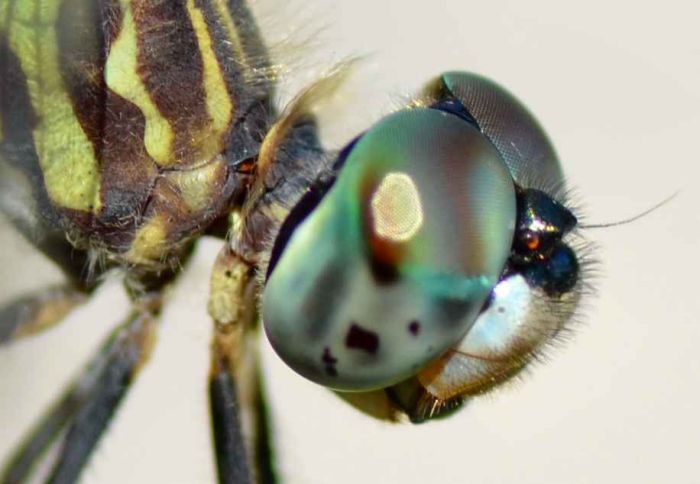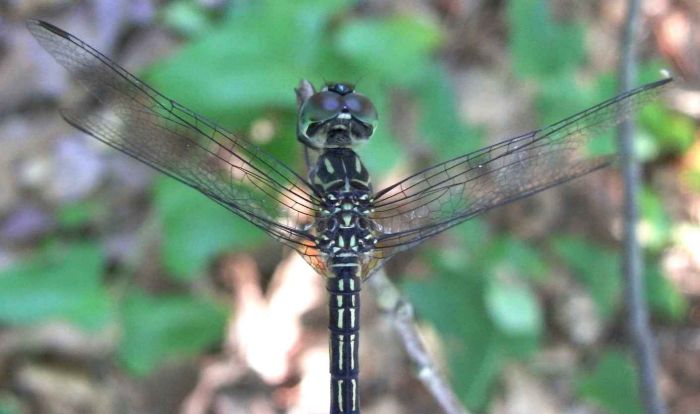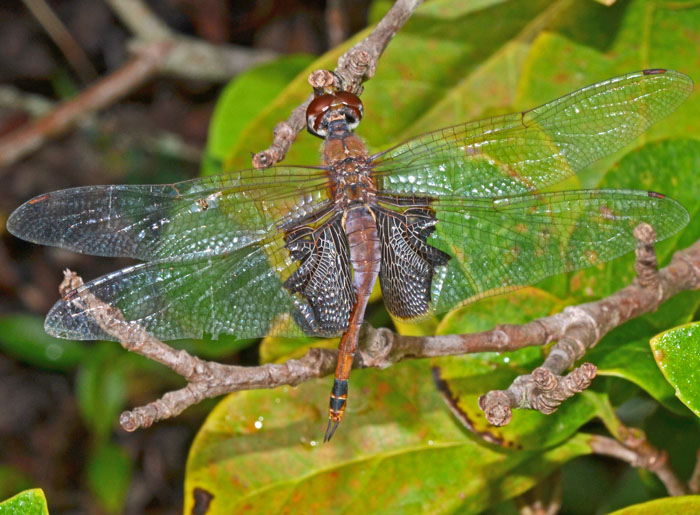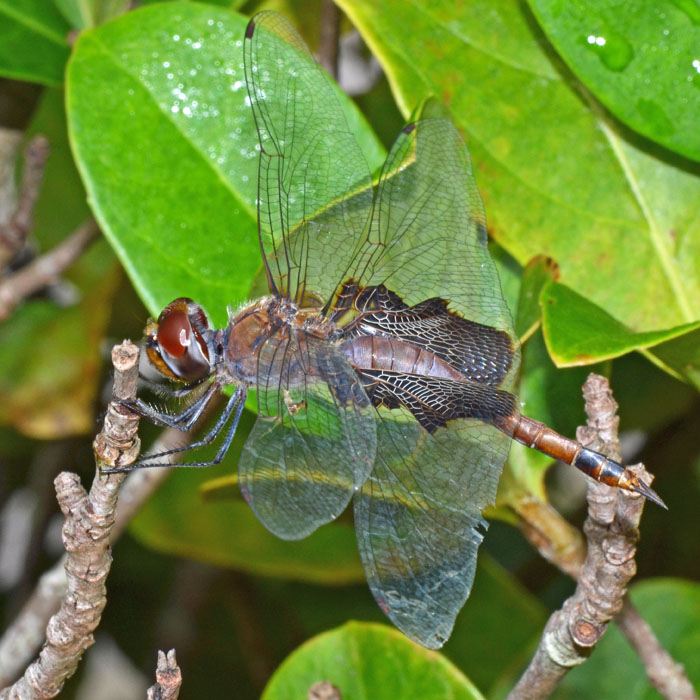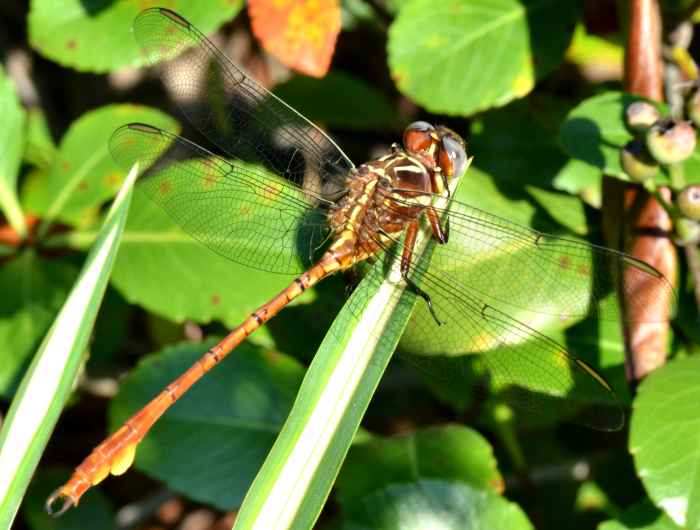 Aphylla williamsoni (Two-striped Forceptail) ♂. | A Clubtail with a characteristic forceps-like tail. In Florida, the Two-Striped Forecptail (Aphylla williamsoni) is the only species in this genus. It has a yellow "W" on the front of the brown thorax and two greenish-yellow stripes on each side. The wing stigmas are pale brown. The eyes are blue-grey and the face is yellow with brown cross stripes. This is a male with characteristic yellow flanges on S8.
bug guide (this photo): http://bugguide.net/node/view/564695 wildflorida.com: http://wildflphoto.com/species.php?k=a&id=224 | ||
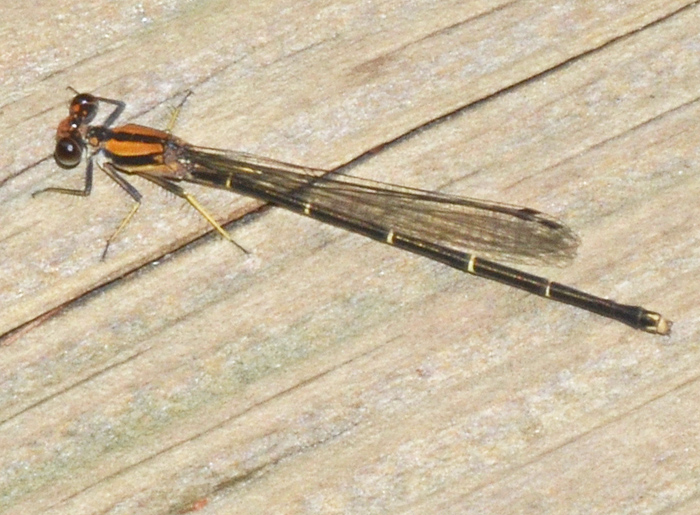 Argia tibialis (Blue-tipped Dancer) ♀. | The females in this species occur in blue and brown forms, but both have wide black shoulder stripes. The abdomen of these dancers is all black with very thin pale rings. The species occurs in thirty US states and is typically found at small, wooded, sandy streams or ponds and less often at larger rivers. I discovered this brown form perching on our deck.
bug guide (this photo): http://bugguide.net/node/view/1220711 Giff Beaton: http://www.giffbeaton.com/DG%20pdfs/Blue-tipped%20Dancer.pdf | ||
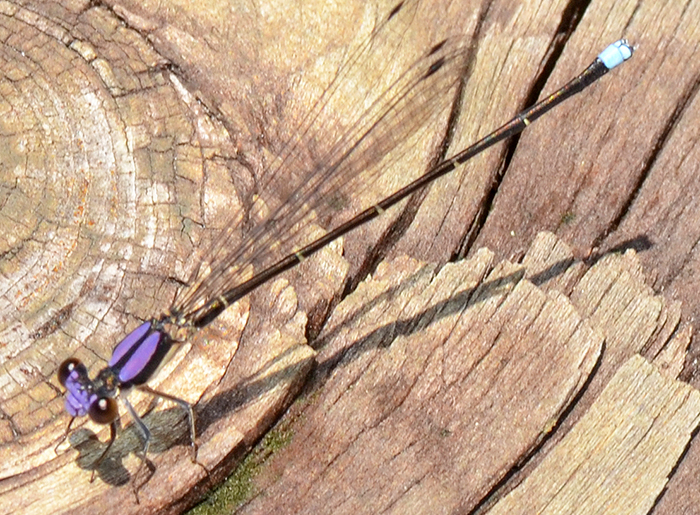 Argia tibialis (Blue-tipped Dancer) ♂. | The thorax of this male specimen has an amazing violet color and is accentuated by a bright blue tale end (abdominal segments 9 and 10). As characteristic for this species, I found it perched on the ground just like the female above. bug guide (this photo): https://bugguide.net/node/view/1561655 | ||
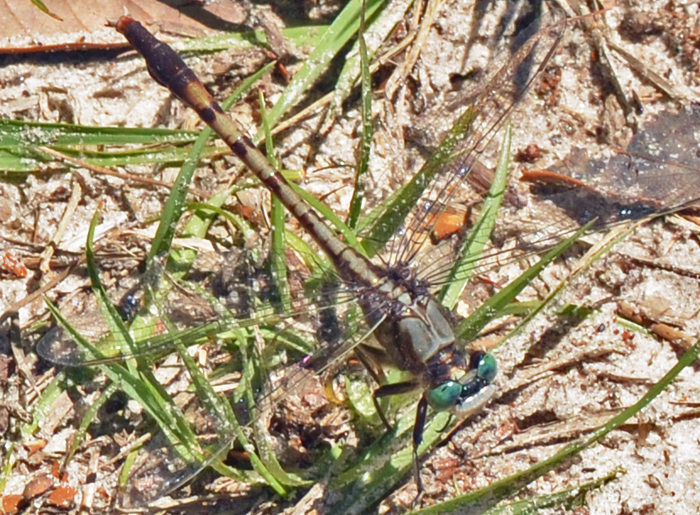 Arigomphus pallidus (Gray-green Clubtail) ♂. | The Gray-green Clubtail is found primarily in Florida, Georgia, and South Carolina and prefers sandy-bottomed streams, ponds, and lakes. It perches on the ground or low growing plants. It is not very colorful but the bright green eyes can be very distinctive. bug guide (this photo): http://bugguide.net/node/view/1354316 Giff Beaton: http://www.giffbeaton.com/clubtails.htm | ||
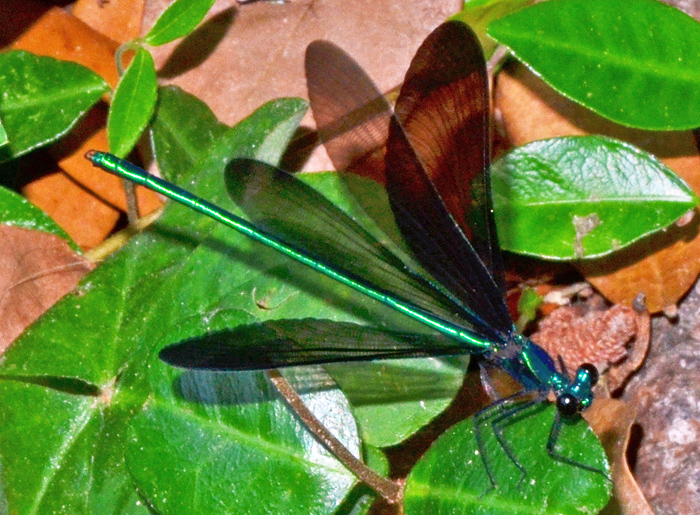 Calopteryx maculata (Ebony Jewelwing) ♂. | ... and here is a male all of which lack the white stigmas and have blueish green bodies. The second link notes that these weak fliers are found in wooded areas near but never at small ponds or creeks, possibly to avoid predation but larger, stronger damsel or dragonflies. Absolutely correct for this example.
bug guide (these photos): http://bugguide.net/node/view/1220332 Eye on Nature: https://eyeonnature.wordpress.com/2012/06/14/winged-jewels/ | ||
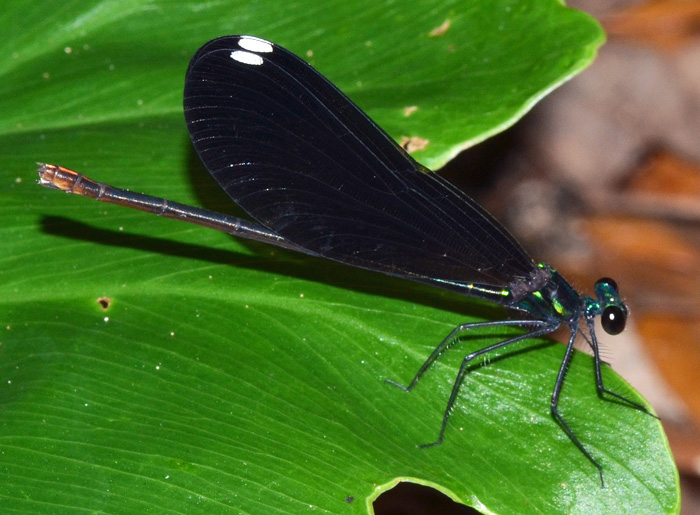 Calopteryx maculata (Ebony Jewelwing) ♀. | What a beautiful and surprising damselfly! The photo clearly shows the female-characteristic white spots on the wings. It was easy to get close because the adults of this species are not very strong fliers and only flutter a short distance when disturbed. Too bad that I couldn't take a picture of the "open", fluttering wings but my 8 GB SDHC card declared itself full after only four photos. Perhaps it needs to be reformatted? bug guide: http://bugguide.net/node/view/601 wikipedia: http://en.wikipedia.org/wiki/Ebony_Jewelwing | ||
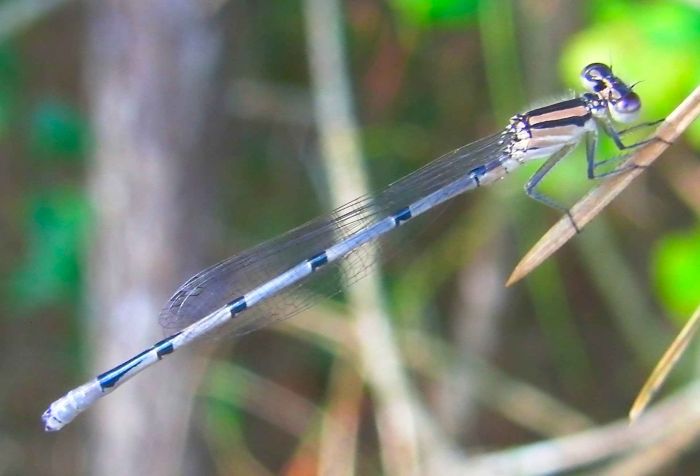 Enallagma sp. (Bluet). | The first damselfly in my collection. Compared to dragonflies, damselflies typically have a slender body and similar sized/shaped fore- and hind-wings which they tend to hold over their body (except for spreadwings). This specimen is a narrow-winged damselfly (a.k.a. pond damselfly) and most likely a bluet (Enallagma sp.). In my area, there are at least three very similar looking species: the familiar bluet (E. civile), the Atlantic bluet (E. doubledayi), and the big bluet (E. durum). bug guide (this photo): http://bugguide.net/node/view/545242 Giff Beaton (pond damselflies in GA): http://www.giffbeaton.com/ponddamsels.htm | ||
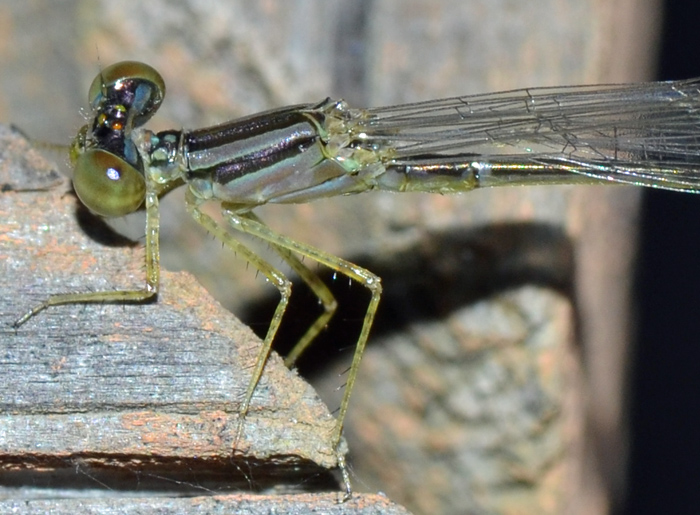 Enallagma signatum (Orange Bluet) ♂. | This is probably a young specimen of Enallagma signatum. It has long grasping cerci that allow the male to hold the female. From wikipedia: "After mating, the pairs will begin laying eggs in floating vegetation or debris, with the male often accompanying his partner underwater. The female will remain underwater, ovipositing in the traditional manner for up to 20 minutes at a time." The Orange Bluet is similar to the Florida Bluet.
bug guide (this photo): http://bugguide.net/node/view/939926 | ||
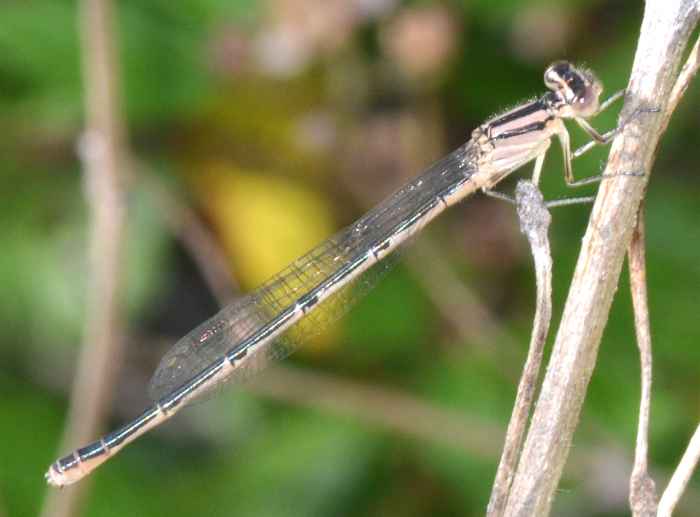 Enallagma sp. (Bluet) ♀. | Another Bluet. This one is definitely an immature female. bug guide (this photo): http://bugguide.net/node/view/632590 | ||
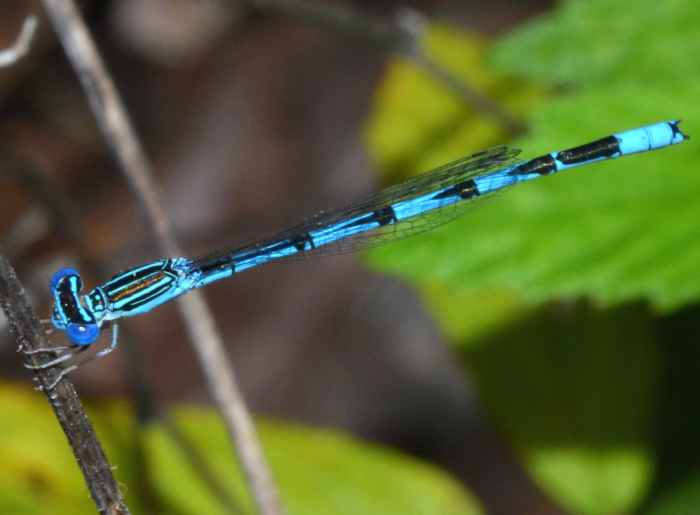 Enallagma basidens (Double-Striped Bluet). | The Double-Striped Bluet (Enallagma basidens) is a rather small bluet. A distinguishing feature of this species is that the black shoulder stripe is cleanly divided by a narrow blue stripe. It can be found throughout most of the US but not the Northwest. bug guide (this photo): http://bugguide.net/node/view/647819 | ||
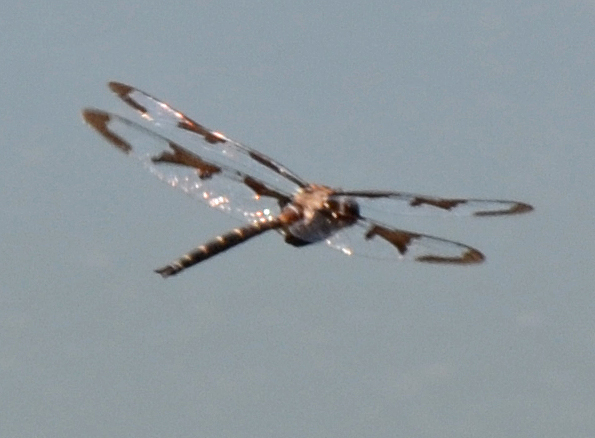 Epitheca princeps (Prince Baskettail). | Not a very good photo but this large dragonfly was constantly flying over our little lake about 10-30' away from my dock. It was also pretty fast and fun too watch. Giff Beaton: http://www.giffbeaton.com/emeralds.htm | ||
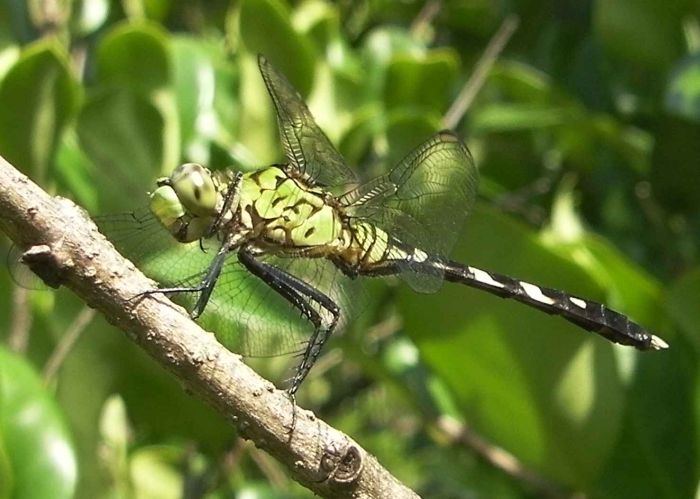 Erythemis simplicicollis (Eastern Pondhawk). | What an amazing animal! This is the Eastern pondhawk (Erythemis simplicicollis). The males of this species turn blue as they get older. These dragonflies are quite common throughout the Eastern US. They hunt flying insects.
The complex pattern on the thorax of this specimen looks more complicated than in reference photos. bug guide: http://bugguide.net/node/view/577 | ||
 Erythrodiplax minuscula (Little Blue Dragonlet) ♀. | This is an unconfirmed identification that is mainly based on a very similar photo in Giff Beaton's book on "Dragonflies and Damselflies of Georgia and the Southeast". I believe it is a Little Blue Dragonlet (Erythrodiplax minuscula). This skimmer is one of North America's smallest dragonflies. Adult males are blue. bug guide (this photo): http://bugguide.net/node/view/574425 UT Austin: http://www.odonatacentral.org/index.php/GalleryAction.getTaxaImages/taxon_id/47029 | ||
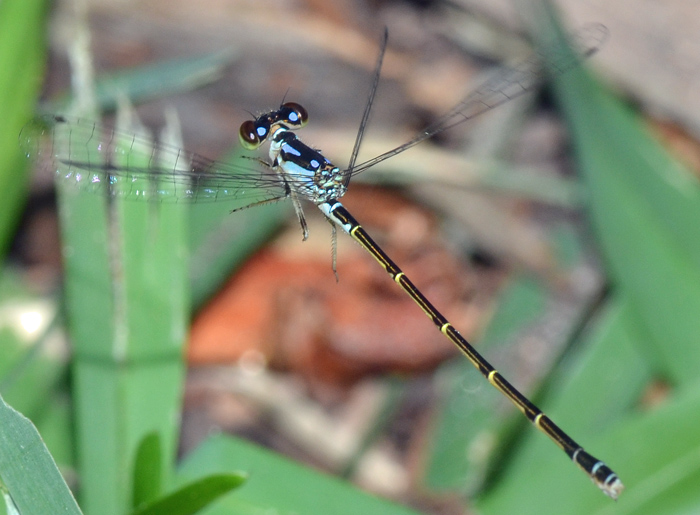 Ischnura posita (Fragile Forktail) ♀. | Fragile Forktails are quite common and can be identified by their "exclamation marks" on the thorax. Males have green marks, females usually have blue ones. Older females are dark pruinose blue and tenerals are soft brown. These small damselflies prefer the shade near the water's edge and the protection of grasses and other plants.
bug guide: http://bugguide.net/node/view/604 | ||
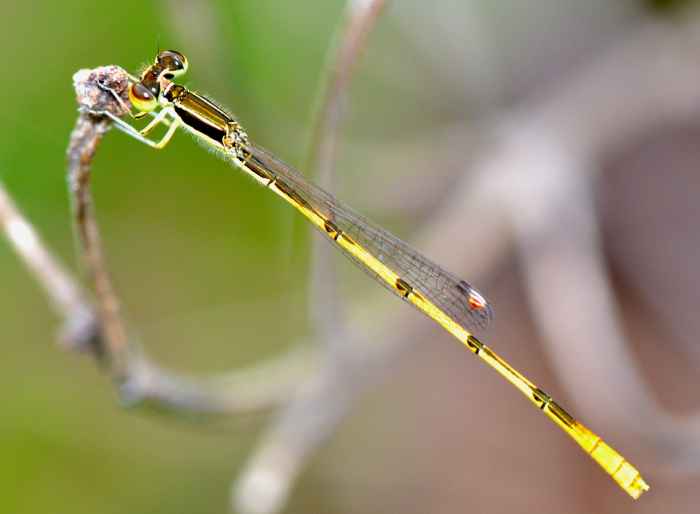 Ischnura hastata (Citrine Forktail) ♂. | Males of Ischnura hastata have mostly yellow abdomen with some black markings. The tip of the abdomen is entirely yellow. It has a striking stigma that distinguishes it from all other damselflies. The Citrine Forktail is also among the very smallest damselfly species in the US. Females are darker orange or olive. bug guide (this photo): http://bugguide.net/node/view/632174 | ||
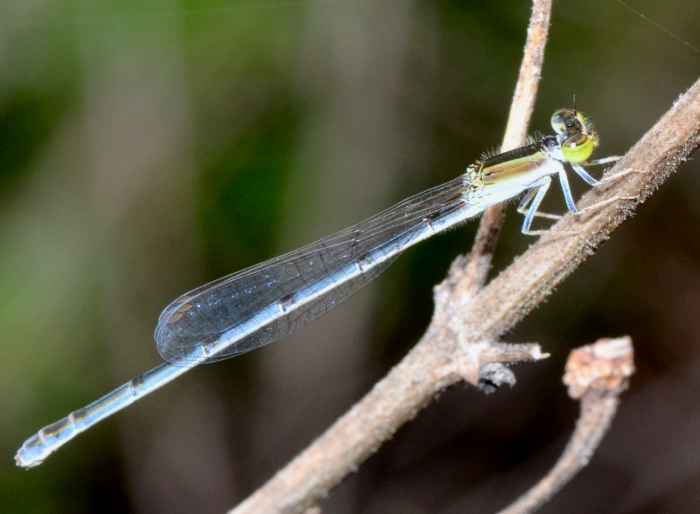 Ischnura hastata (Citrine Forktail) ♀. | And here is the olive, blue female of the Citrine Forktail Ischnura hastata. When I took this photo, there were several blueish and yellow mini-damselflies in an area measuring a few feet.
bug guide (these photos): http://bugguide.net/node/view/632182 | ||
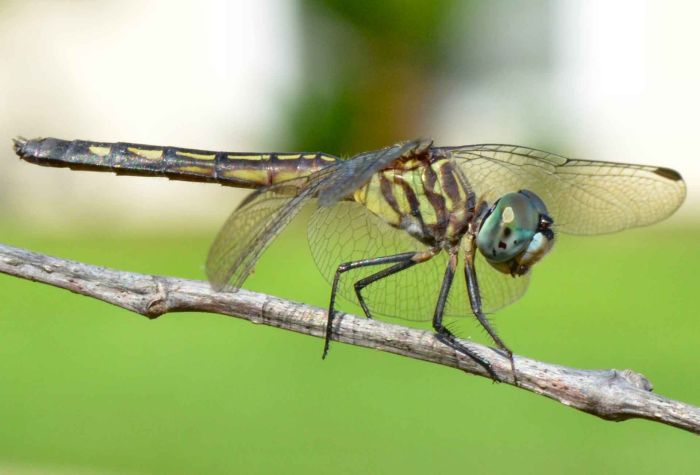 Pachydiplax longipennis (Blue Dasher) ♀. | Another dragonfly: a female blue dasher Pachydiplax longipennis. This one is a skimmer. Below is a close-up of the face (left photo) and another specimen (right photo).
 A short video is available on my YouTube channel. A short video is available on my YouTube channel.bug guide (this photo): http://bugguide.net/node/view/548310 | ||
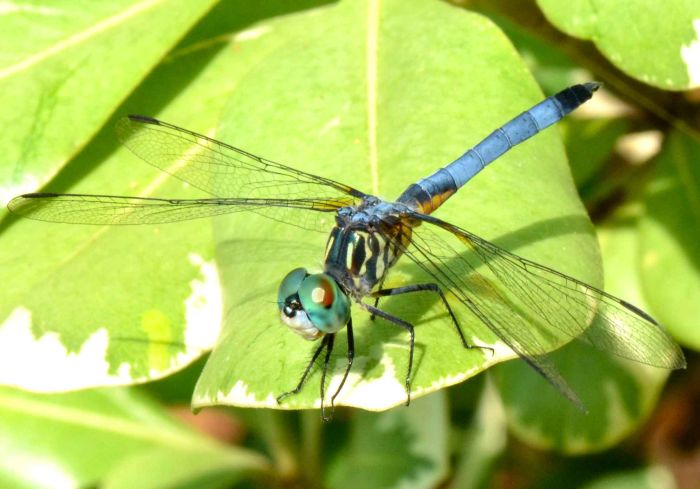 Pachydiplax longipennis (Blue Dasher) ♂. | As for many other dragonflies, the males look quite different. This here is a male blue dasher Pachydiplax longipennis. The mature male is completely (powdery) blue. The bug guide refers to this stage (half-jokingly) as "tweens".  A short video is available on my YouTube channel. A short video is available on my YouTube channel.bug guide: http://bugguide.net/node/view/598 | ||
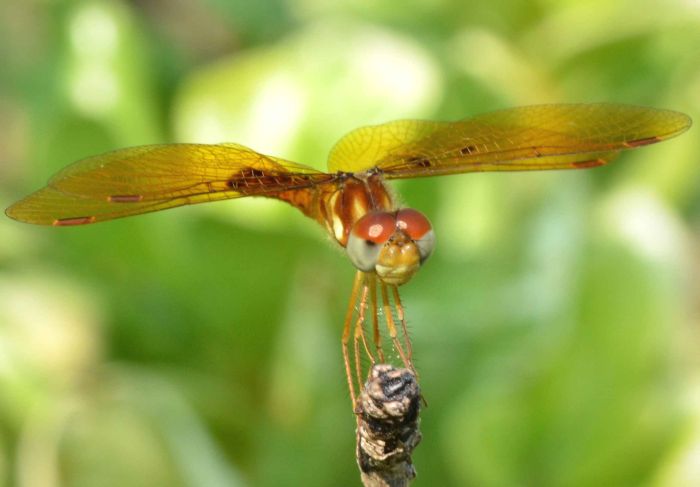 Perithemis tenera (Eastern Amberwing) ♂. | A male Eastern amberwing (Perithemis tenera). This skimmer is a little smaller than one inch. In the Eastern states P. tenera is the only species of this genus. Males (females) have red (brown) wing spots. Males defend their 5' wide territory fiercely. bug guide: http://bugguide.net/node/view/8058 insects of WV: http://www.insectsofwestvirginia.net/d/perithemis-tenera.html | ||
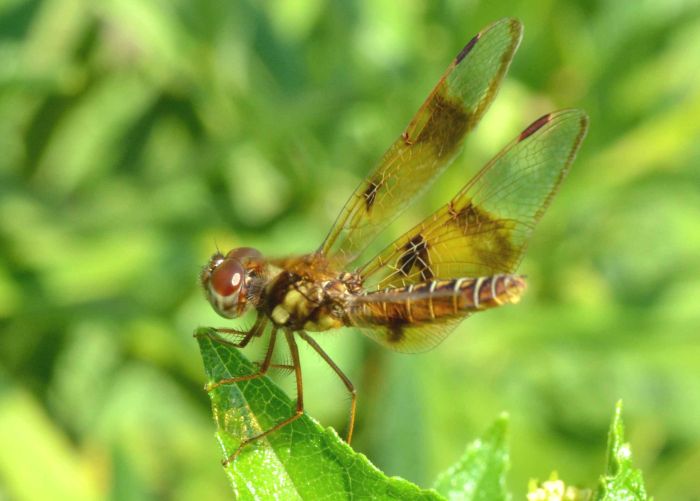 Perithemis tenera (Eastern Amberwing) ♀. | ... and here is a female Eastern amberwing (Perithemis tenera). Notice that the wings of females are more transparent while males have beautiful amber-colored wings. bug guide: http://bugguide.net/node/view/8058 insects of WV: http://www.insectsofwestvirginia.net/d/perithemis-tenera.html | ||
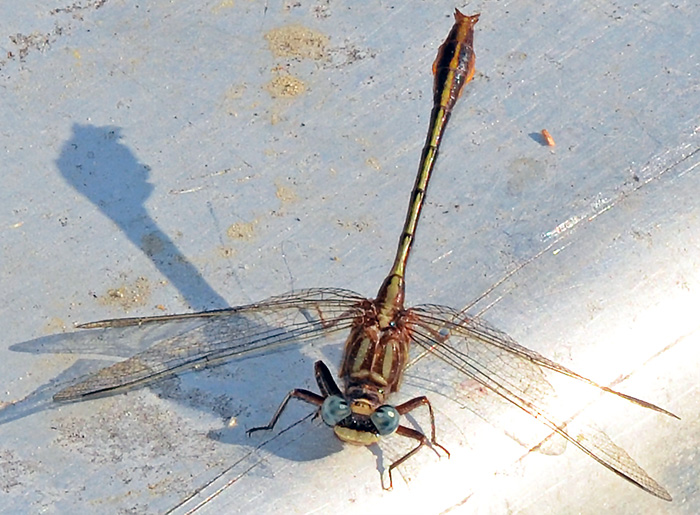 Phanogomphus sp.. | This dragonfly is probably Phanogomphus minutus, the Cypress Clubtail. I actually found this specimen perching on a little, abandoned rowboat that drifted against my dock. If you have lost a boat on Lake Monkey Business, let me know, hahaha. bug guide (this photo): https://bugguide.net/node/view/1793292 | ||
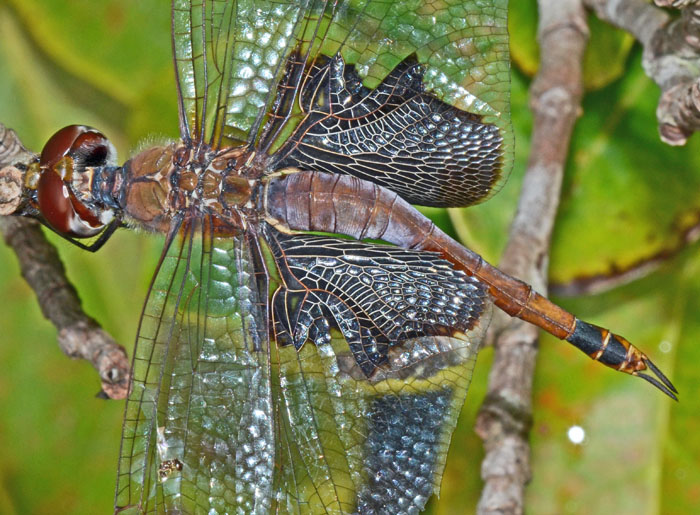 Tramea sp. (Saddlebag). | This skimmer belongs to the Saddlebags (Tramea sp.) also known as Dancing Gliders. They typically have colored bases to their otherwise translucent hindwings. There are seven species in the US. So far the best guess for this specimen is Teneral Male Black Saddlebags (T. lacerata).
bug guide (these photos): http://bugguide.net/node/view/688259 |

